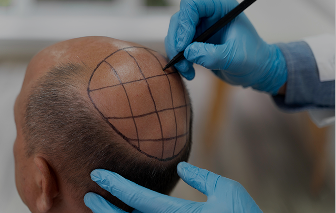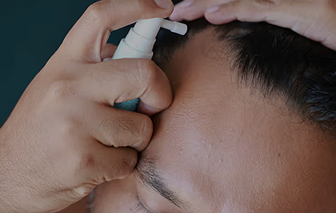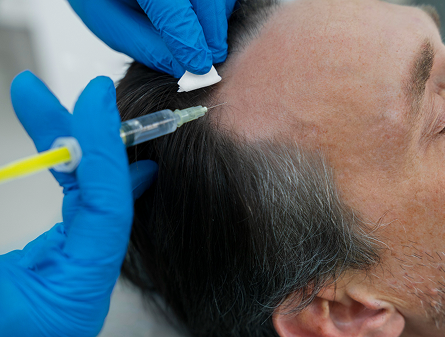A hair transplant is a surgical procedure where healthy hair is extracted from a donor area, usually at the back of the scalp, and implanted into balding areas. Once the transplanted grafts have had time to adapt, they will start to produce hairs after 3 to 4 months. Finasteride is an FDA-approved hair regrowth medication for male pattern hair loss.
It is typically taken as an oral medication daily to block the production of dihydrotestosterone (DHT) which causes hair follicles to shrink and weaken. A hair transplant is a significant time and financial investment that can provide long-lasting results and may only be required as a once-off solution.
Finasteride is a pharmacological solution that can be easily incorporated into your life and be used as a long-term solution to tackling hair loss. Check out the comparison table below to see which treatment is right for you.
- A hair transplant is a surgical procedure that relocates hair follicles to balding areas for permanent results.
- Unlike finasteride, it addresses visible hair loss with immediate, physical redistribution.
- Finasteride is an oral medication that reduces DHT levels to slow down genetic hair loss.
- Compared to a hair transplant, it’s non-surgical and supports existing hair follicles.
- Hair transplants in Australia cost between $5,000 and $15,000, depending on the number of grafts required.
- Higher upfront cost than finasteride, but may be a one-time expense.
- Finasteride typically costs $30–$70 per month.
- Unlike hair transplants, it’s ongoing and accumulates cost over time.
- Transplants are performed in one or two sessions, with full results visible after 6–12 months.
- Minimal upkeep after recovery.
- Finasteride is taken daily, with results showing within 3–6 months.
- Compared to hair transplants, the commitment is ongoing and indefinite.
- Hair transplants physically move follicles using surgical techniques like FUE or FUT.
- Aesthetic results are immediate once hair regrows.
- Finasteride works internally to block DHT and prevent hair thinning.
- Unlike transplants, it does not replace lost follicles.
- Hair transplants carry surgical risks like infection, scarring, or swelling.
- Considered safe when performed by experienced professionals.
- Finasteride may cause sexual side effects and mood changes in some users.
- Compared to hair transplants, it poses hormonal risks but avoids surgical complications.
- Transplants require a one-time clinic visit and a recovery period.
- Less daily effort once the healing process is complete.
- Finasteride is taken as a pill once a day.
- Unlike a transplant, it’s easier to implement but requires daily discipline.
- Hair transplants require specialist consultation and access to a qualified clinic.
- Less accessible due to cost, location, and surgeon availability.
- Finasteride is prescription-only but widely available in Australian pharmacies.
- Compared to transplants, it is easier and quicker to obtain.
- Transplanted hair is generally permanent and continues to grow naturally.
- No ongoing use or repeat sessions needed after successful recovery.
- Finasteride results can only be enjoyed with continued use.
- Unlike hair transplants, stopping it leads to resumed hair loss.
- Hair transplants can be combined with finasteride or minoxidil for long-term hair maintenance of non-transplanted hair.
- It can be used as a foundation in multi-treatment plans or as solo therapy.
- Finasteride is frequently prescribed post-transplant to preserve native hair or combined with topical solutions like minoxidil.
- Compared to a transplant, it is often used in combination with other treatments.
- Hair transplants appeal to users seeking a lasting, visible transformation.
- Surgery can be a cause for concern for some users.
- Finasteride appeals to those who prefer subtle, ongoing control over hair loss.
- Unlike transplants, it doesn’t offer instant visual results, and potential sexual side effects can worry users.
- Hair transplants restore a natural hairline and volume but offer no systemic health benefits.
- Limited to cosmetic improvement only.
- Finasteride reduces DHT and may protect against prostate enlargement.
- Compared to transplants, it offers a systemic approach to hair loss.
- Transplants generate one-time clinical waste during surgery.
- Minimal long-term environmental impact.
- Finasteride contributes to monthly packaging waste from continuous prescriptions.
- Less eco-friendly than a one-off surgical solution.
Shop our hair solutions
We are committed to providing affordable hair regeneration services for people all over Australia. Our formula can help you regain your confidence.
Shop Now

Hair Transplant vs Finasteride Cost and Effectiveness Comparison Summary
A hair transplant can provide an effective treatment for covering balding areas of the scalp. It is best suited for people whose hair loss has stabilised as the hair surrounding the recipient site will continue to fall out if hair loss persists. This can create an unnatural division between the transplanted region and the rest of your scalp.
Finasteride is designed to be taken as a medication in a long-term capacity which can help to fight the progression of hair loss. It is best to start this treatment at the first signs of hair loss at a young age to halt the progress of hair loss.
A hair transplant is an expensive procedure that will require significant planning and particular attention to aftercare instructions to ensure the best results. Finasteride is comparatively a cheaper solution but costs may add up cumulatively over years so a hair transplant could be a better investment.
User Guidance
A hair transplant typically takes place in a 4-8 hour session depending on the amount of grafts being transplanted. If you are seeking a non-pharmacological solution that can provide long-lasting results a hair transplant may be suitable for you.
There are risks associated with a hair transplant as it is a surgical procedure so research will be required beforehand into the surgeon performing your hair transplant and the clinic it is being performed in to ensure safety and optimal results.
Finasteride is similar across formulations with some daily hair loss pills containing combinations of other pharmacological ingredients as well as nutraceuticals to combat hair loss from different causes.
Take Our Hair Loss Quiz to See Which Treatment Suits You?
Take A Hair Quiz

Frequently Asked Questions
We have put some commonly asked questions.
Nunc scelerisque tincidunt elit. Vestibulum non mi ipsum. Cras pretium suscipit tellus sit amet aliquet. Vestibulum maximus lacinia massa nontor.
Platelet-rich plasma (PRP) treatment involves drawing blood from the patient, isolating the beneficial nutrients and injecting it into the scalp where hair loss is occurring. This promotes hair growth and has many other applications from encouraging healing to skin rejuvenation.
Platelet-rich plasma (PRP) treatment involves drawing blood from the patient, isolating the beneficial nutrients and injecting it into the scalp where hair loss is occurring. This promotes hair growth and has many other applications from encouraging healing to skin rejuvenation.
Platelet-rich plasma (PRP) treatment involves drawing blood from the patient, isolating the beneficial nutrients and injecting it into the scalp where hair loss is occurring. This promotes hair growth and has many other applications from encouraging healing to skin rejuvenation.







 See All
See All